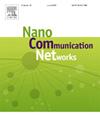Internet of harvester nano things: A future prospects
IF 4.7
4区 计算机科学
Q2 ENGINEERING, ELECTRICAL & ELECTRONIC
引用次数: 0
Abstract
The advancements in nanotechnology, material science, and electrical engineering have shrunk the sizes of electronic devices down to the micro/nanoscale. This brings the opportunity of developing the Internet of Nano Things (IoNT), an extension of the Internet of Things (IoT). With nanodevices, numerous new possibilities emerge in the biomedical, military fields, and industrial products. However, a continuous energy supply is mandatory for these devices to work. At the micro/nanoscale, batteries cannot supply this demand due to size limitations and the limited energy contained in the batteries. Internet of Harvester Nano Things (IoHNT), a concept of Energy Harvesting (EH) integrated with wireless power transmission (WPT) techniques, converts the existing different energy sources into electrical energy and transmits to IoNT nodes. As IoHNTs are not directly attached to IoNTs, it gives flexibility in size. However, we define the size of IoHNTs as up to 10 cm. In this review, we comprehensively investigate the available energy sources and EH principles to wirelessly power IoNTs. We discuss the IoHNT principles, material selections, and state-of-the-art applications of each energy source for different sectoral applications. The different technologies of WPT and how communication is influenced by the incorporation of IoHNTs to power IoNTs are discussed with the future research directions. IoHNTs represent a shift in the nanodevice power supply, leading us towards a future where wireless technology is widespread. Hence, it will motivate researchers to envision and contribute to advancing the following power revolution in IoNT, providing unmatched simplicity and efficiency.
纳米物联网收割机:未来前景
纳米技术、材料科学和电气工程的进步已经将电子设备的尺寸缩小到微/纳米级。这为发展物联网(IoT)的延伸——纳米物联网(IoNT)带来了机遇。有了纳米器件,在生物医学、军事领域和工业产品中出现了许多新的可能性。然而,持续的能源供应是这些设备工作的必要条件。在微/纳米尺度上,由于尺寸限制和电池中所含能量有限,电池无法满足这种需求。物联网收割机纳米物联网(IoHNT)是一种能量收集(EH)概念,与无线电力传输(WPT)技术相结合,将现有的不同能源转化为电能,并传输到物联网节点。由于iohnt不直接连接到iot,因此它在大小上具有灵活性。然而,我们将iohnt的大小定义为10厘米。在这篇综述中,我们全面研究了无线充电的可用能量来源和EH原理。我们讨论了IoHNT原理,材料选择,以及不同部门应用中每种能源的最新应用。讨论了WPT的不同技术,以及iohnt与iont结合对通信的影响,并展望了未来的研究方向。iohnt代表了纳米器件供电的转变,引领我们走向无线技术广泛应用的未来。因此,它将激励研究人员设想并为推进IoNT的后续电力革命做出贡献,提供无与伦比的简单性和效率。
本文章由计算机程序翻译,如有差异,请以英文原文为准。
求助全文
约1分钟内获得全文
求助全文
来源期刊

Nano Communication Networks
Mathematics-Applied Mathematics
CiteScore
6.00
自引率
6.90%
发文量
14
期刊介绍:
The Nano Communication Networks Journal is an international, archival and multi-disciplinary journal providing a publication vehicle for complete coverage of all topics of interest to those involved in all aspects of nanoscale communication and networking. Theoretical research contributions presenting new techniques, concepts or analyses; applied contributions reporting on experiences and experiments; and tutorial and survey manuscripts are published.
Nano Communication Networks is a part of the COMNET (Computer Networks) family of journals within Elsevier. The family of journals covers all aspects of networking except nanonetworking, which is the scope of this journal.
 求助内容:
求助内容: 应助结果提醒方式:
应助结果提醒方式:


